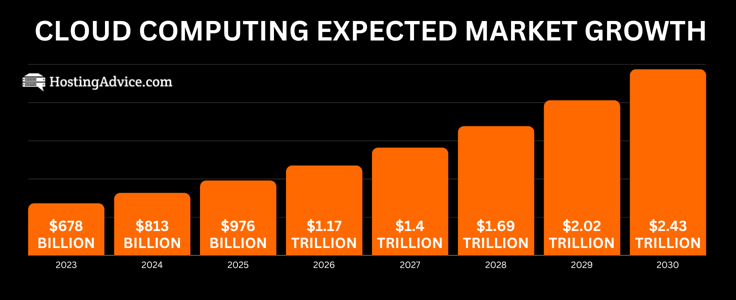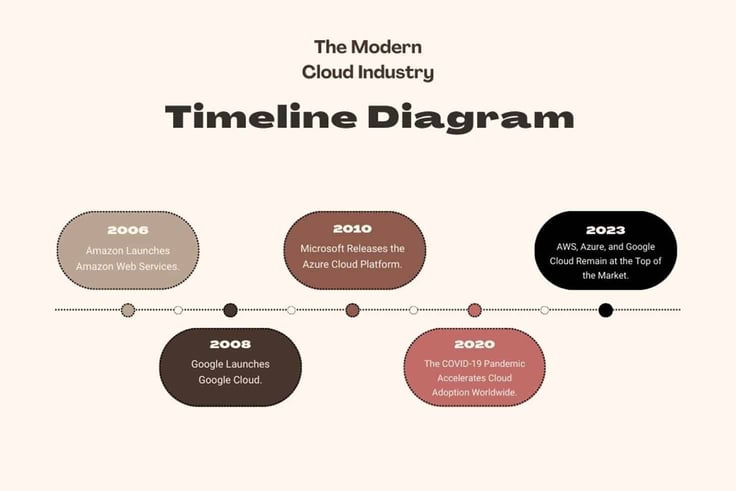
The cloud has come a long way since its inception. Although its roots date back to the 1960s, cloud computing — the remote on-demand access to computer data storage and computing power over the internet — only became a mainstream choice in the 2010s. Before then, companies stored their data and software on their own hard drives and servers. Amazon, Apple, Google, and other tech giants led the way for the adoption of the cloud in the tech industry with products including AWS, iCloud, and Google Docs.
While your digital assets aren’t freely floating up there in the atmosphere, cloud computing has made it possible for documents and files to be accessed from anywhere. This same accessibility and flexibility has helped accelerate its adoption in recent years. During the COVID-19 pandemic, the cloud enabled companies to build with more collaboration, scalability, and agility. Remote teams could access the same files across multiple devices, and companies could scale resources when needed.
And the cloud’s history has proved to be as ever-changing as its shape-shifting physical counterpart in the sky. Since the COVID-19 pandemic shook up the digital world, more businesses than ever before have adopted the cloud, making it the primary choice for companies, both large and small. But the more you use something, the more you learn about it. And users all over the world are gearing up to optimize their cloud usage in new, innovative ways.
Below, we list the top statistics about the cloud computing market and how it may evolve in the coming years. Stick around for some enlightening facts to elevate your cloud strategy.
1. More Than 92% of Organizations Use Cloud Computing
The COVID-19 pandemic sped up cloud adoption for companies worldwide. As employees went remote, organizations needed a secure way to give teams access to company data and applications. Because of this, more than 92% of organizations are now using the cloud1.
2. Cloud Spending Is Expected to Increase by 22% In 2023
Cloud spending is trending upward. Companies will spend 22% more on cloud computing in the next year alone2. This increase can be attributed to the cloud’s flexibility in managing workloads.

The cloud allows organizations to access their data and applications from anywhere in the world. It’s secure, accessible, and scalable for companies of all sizes.
3. Individuals Use 36 Cloud-Based Services Daily
The cloud isn’t just for business. Research shows that people prefer it for personal use as well. On average, individuals use up to 36 cloud-based apps and services on a daily basis2.
Popular devices, like iPhones, store your photos and files in the cloud. The same applies to Google Workspace users who take advantage of Google’s many cloud-based productivity tools.
4. Amazon Web Services (AWS) Owns The Largest Cloud Market Share At 33%
Amazon Web Services was one of the first cloud providers and played a pivotal role in standardizing cloud services used in the market. Amazon launched the cloud service in 2006 and never looked back. That same year, Google released Google Docs, which allows users to share and edit documents in a collaborative environment.

It’s no surprise that AWS holds such a massive share of the cloud market. Being one of the first to make a mark, AWS has offered cloud-based services, including storage and computation, for almost 20 years. Its next closest rivals are Microsoft Azure and Google Cloud, which both launched more than two years after AWS.3
5. Monthly Rates For Basic Cloud Hosting Average $8.47
Cloud computing has become a popular choice not only among enterprises but also among small businesses and individual users. Many budget web hosting companies have added cloud hosting plans to their platforms in the last few years. After all, it is difficult to overlook the opportunity with its rising popularity and unmatched capabilities.
Cloud hosting usually falls between shared hosting and dedicated servers, right in the middle with VPS plans, on the hosting spectrum. Often mentioned together, cloud and VPS hosting share similarities, as they are both flexible and scalable in price and performance. Cloud hosting’s average base price is a great median price for the resources users receive.4
6. China Telecom Has the World’s Largest Datacenter, Holding 50% of the Chinese Datacenter Market Share
The China Telecom Datacenter is home to the largest datacenter in the world. Located in Hohhot, China, the nearly 10.8-million-square-foot datacenter lives within Inner Mongolia Information Park. The China Telecom Datacenter and its extensive global network owns more than 50% of the Chinese datacenter market share, justifying the magnitude of its size.5
Its location in the Beijing-Tianjin economic circle places it in a prime area for efficient data transmission and cloud computing. The year-round average temperature sits at 42.8 Fahrenheit, making free air cooling possible for up to eight months a year.
Inner Mongolia Information Park is also home to the second largest datacenter. The China Mobile datacenter is just a few million square feet smaller than its neighbor we mentioned above.
7. The Cloud Stores 60% of Global Corporate Data
Cloud storage has become the go-to resource for companies to store their data. In 2018, users generated 2.5 quintillion bytes — or 2.5 million terabytes — of data every day. With data production at an all-time high, companies leverage cloud storage to house and access their data for their applications and operational workflows.

By 2025, the cloud will store about 200 ZB of data.6 As the corporate world’s reliance on SaaS or other-as-a-service applications increases, companies will look to robust cloud storage solutions to carry the weight of the data generation related to these applications.
8. 61% of Businesses Plan to Optimize Cloud Costs in 2023
Cloud spending has grown dramatically over the last few years. Companies now rely on more cloud-based applications and infrastructure to power their daily operations. Although the cloud may have price flexibility, users are finding that it isn’t as affordable as they thought. They have to factor in software, services vendors, and hardware, which will drive up cloud costs across the board.
Optimizing cloud costs will be at the top of the list for many companies in 2023 as they try to find ways to save on operating expenditures.7
9. The Top Cloud Hosting Providers are AWS (33%), Microsoft Azure (23%), and Google Cloud (11%)
As three of the most prominent cloud pioneers in the modern era, it is no surprise that AWS, Azure, and Google Cloud reign at the top of the cloud hosting providers list. In the last year, Microsoft Azure increased its market share by 2%, from 21% to 23%. Google Cloud remains steady at 11%, while AWS sits at the apex with 33%, decreasing by 1%.8

These three cloud providers offer robust platforms to power public, private, multicloud, and hybrid cloud strategies. They also boast more than a decade of experience and expertise over most of their competitors, assisting some of the largest Fortune 500 companies in the world.
The Cloud Industry Continues to Help Businesses Reach Their Goals
The cloud industry has evolved in many ways, and its growth doesn’t seem to be stopping anytime soon. As companies learn of its benefits, many will continue to scale their operations with cloud infrastructure and leverage cloud-based applications for their workflows. More developers are also building cloud-native apps and need cloud storage to store and manage their data.
Businesses are learning to optimize how they use and integrate cloud services into their operations. With the amount of data growing every day, users will look to secure cloud storage solutions to keep their data in a safe and trusted place. Companies will also set out to optimize their cloud expenditure budgets by leveraging various infrastructure strategies and monitoring resource usage for their cloud-based workloads. One thing is for sure: The cloud will continue to rise over its competition in the coming years.
Sources and Further Reading
Our statistics in this guide are comprised of internal research and reputable sources. If you’re interested in learning more, check out some of these sites for further reading.
- https://www.cloudzero.com/blog/cloud-computing-statistics & https://www.zippia.com/advice/cloud-adoption-statistics/
- https://aag-it.com/the-latest-cloud-computing-statistics/, https://www.gartner.com/en/newsroom/press-releases/2022-10-31-gartner-forecasts-worldwide-public-cloud-end-user-spending-to-reach-nearly-600-billion-in-2023, & https://techjury.net/blog/cloud-computing-statistics/
- https://www.srgresearch.com/articles/as-quarterly-cloud-spending-jumps-to-over-50b-microsoft-looms-larger-in-amazons-rear-mirror
- https://www.hostingadvice.com/best/cloud-hosting/
- https://www.rankred.com/largest-data-centers-in-the-world/
- https://explodingtopics.com/blog/cloud-computing-stats
- https://www.zippia.com/advice/cloud-adoption-statistics/
- https://dgtlinfra.com/top-10-cloud-service-providers-2022/
If you want more information on cloud hosting or need cloud services, check out our recommended cloud hosting services here.







